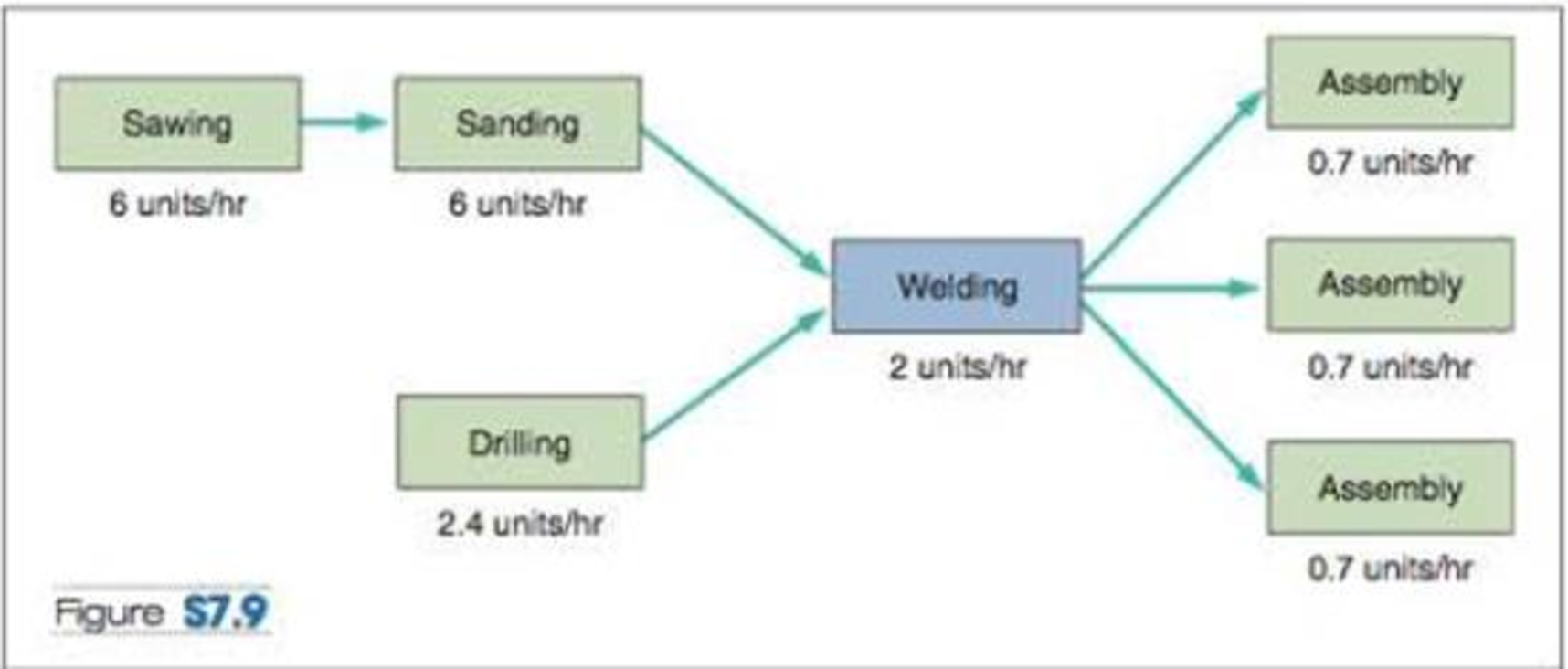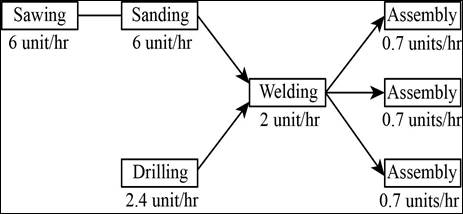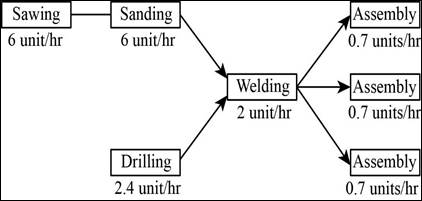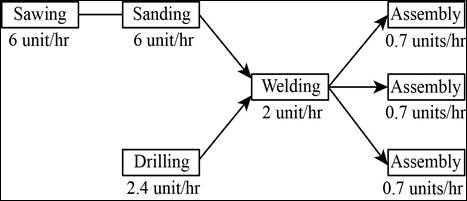
Concept explainers
10 minutes per unit. Part 2 is simultaneously processed at work-station C for 20 minutes per unit. Work stations B and C feed the parts to an assembler at workstation D. w here the two parts are assembled. The time at workstation D is 15 minutes.
a) What is the bottleneck of this process?
b) What is the hourly capacity of the process?
•• S7.15 A production process at Kenneth Day Manufacturing is shown in Figure S7.9. The drilling operation occurs separately from, and simultaneously with, sawing and sanding, which are independent and sequential operations. A product needs to go through only one of the three assembly operations (the operations are in parallel).
a) Which operation is the bottleneck?
b) What is the bottleneck time?
c) What is the throughput time of the overall system?
d) If the firm operates 8 hours per day. 20 days per month, what is the monthly capacity of the manufacturing process?

a)
To determine: The bottleneck operation.
Introduction:
Bottleneck time:
The bottleneck time of the system is the process in the system which takes the most amount of time to complete its activity. The bottleneck time will reduce the overall efficiency of the system.
Answer to Problem 15P
The bottleneck operation is Welding.
Explanation of Solution
Given information:

Formula to convert capacity into process time:
Formula to calculate overall assembly operation process time:
Calculation of process time for each operation:
The process time of each station is calculated by dividing the number of minutes with the production capacity of the station.
Sawing:
Sanding:
Drilling:
Sawing:
Welding:
Assembly at one operation:
Calculation of overall assembly operation process time:
The overall assembly operation process time is calculated by dividing the process time at one assembly operation by the Number of assembly operations.
Identification of the bottleneck time of the system:
The bottleneck time of the system is the operation which has the highest process time. Welding has the highest process time when compared to the other operations (30>10, 10, 25, 10, 28.57). Hence, the bottleneck time of the system is 30 minutes per unit.
Therefore, the bottleneck operation is Welding.
b)
To determine: The bottleneck time of the bottleneck operation.
Introduction:
Bottleneck time:
The bottleneck time of the system is the process in the system which takes the most amount of time to complete its activity. The bottleneck time will reduce the overall efficiency of the system.
Answer to Problem 15P
The bottleneck time of the bottleneck operation is 30.
Explanation of Solution
Given information:

Formula to convert capacity into process time:
Formula to calculate overall assembly operation process time:
Calculation of process time for each operation:
The process time of each station is calculated by dividing the number of minutes with the production capacity of the station.
Sawing:
Sanding:
Drilling:
Sawing:
Welding:
Assembly at one operation:
Calculation of overall assembly operation process time:
The overall assembly operation process time is calculated by dividing the process time at one assembly operation by the number of assembly operations.
Identification of the bottleneck time of the system:
The bottleneck time of the system is the operation which has the highest process time. Welding has the highest process time when compared to the other operations (30 > 10, 10, 25, 10, 28.57). The bottleneck operation is Welding.
Hence, the bottleneck time of the bottleneck operation is 30 minutes per unit.
c)
To determine: The throughput time of the time of the overall system.
Introduction:
Throughput time:
The throughput time of a system is the time taken for a product to pass from the raw materials stage to the finished goods stage. The higher the throughput time the more efficient the system will be.
Answer to Problem 15P
The throughput time of the overall system is 140.71 minutes.
Explanation of Solution
Given information:

Formula to convert capacity into process time:
Formula to calculate throughput time:
Calculation of process time for each operation:
The process time of each station is calculated by dividing the number of minutes with the production capacity of the station.
Sawing:
Sanding:
Drilling:
Sawing:
Welding:
Assembly at one operation:
Calculation of throughput time:
The throughput time is calculated by identifying the maximum value of the summation of process times of Sanding, Sawing, Welding, assembly and the summation of process times of Drilling, Welding, and Assembly.
Hence, the throughput time of the overall system is 140.71 minutes.
d)
To determine: The monthly capacity of the manufacturing process.
Introduction:
Bottleneck time:
The bottleneck time of the system is the process in the system which takes the most amount of time to complete its activity. The bottleneck time will reduce the overall efficiency of the system.
Monthly capacity:
The monthly capacity is the number of units the firm is able to produce in a month’s time. It will be calculated taking into consideration of the resources and constraints present in the manufacturing process.
Answer to Problem 15P
The monthly capacity of the manufacturing process is 320 units per month.
Explanation of Solution
Given information:

Operating time = 60 minutes / 8 hour / day
Number of days = 20 / month
Formula to convert capacity into process time:
Formula to calculate overall assembly operation process time:
Formula to calculate monthly capacity:
Calculation of process time for each operation:
The process time of each station is calculated by dividing the number of minutes with the production capacity of the station.
Sawing:
Sanding:
Drilling:
Sawing:
Welding:
Assembly at one operation:
Calculation of overall assembly operation process time:
The overall assembly operation process time is calculated by dividing the process time at one assembly operation by the Number of assembly operations.
Identification of the bottleneck time of the system:
The bottleneck time of the system is the operation which has the highest process time. Welding has the highest process time when compared to the other operations (30 > 10, 10, 25, 10, 28.57). Hence, the bottleneck time of the system is 30 minutes per unit.
Calculation of monthly capacity:
The monthly capacity is calculated by multiplying the operating time per day with the number of days per month and dividing the resultant value with the bottleneck time of the system.
Hence, the monthly capacity of the manufacturing process is 320 units per month.
Want to see more full solutions like this?
Chapter 7 Solutions
Principles Of Operations Management
- what is an other difination for principle?arrow_forwardNeed help or ideas to design out two slides as my script and writing quite long to squeese into two slides. But can just point form in slides with correct title and a good script for me to present two slides in only 2.5 mins. Following is my draft, pls guide me step by step on powerpoint creation and good script to present findings. My draft: Slide 1: Foreign Labor Exploitation in Dyson's Supply Chain Introduction Dyson's former Malaysian supplier, ATA IMS Bhd, became embroiled in serious labor exploitation allegations in 2021. These concerns surfaced when whistleblowers exposed unethical labor practices affecting migrant workers, primarily from Nepal and Bangladesh. Key Forms of Exploitation Debt Bondage Due to Recruitment Fees Workers were forced to pay exorbitant recruitment fees before securing employment, often taking loans at high interest rates. This financial burden trapped them in debt bondage, leaving them with little choice but to accept exploitative working…arrow_forwardNot use ai pleasearrow_forward
- The Business Development Bank of Canada. (2023). Canadian economic outlook for 2024: Shifting into neutral. https://www.bdc.ca/en/articles-tools/blog/canadian-economic-outlook-for-2024-shifting-into-neutral “Despite persistently high inflation and rising interest rates, the news was generally better than expected for the Canadian economy in 2023” (BDC Blog 2024). Discussion Question: In your view, what are the most pressing problems for Canadian companies or consumers in 2024? Explain your answer using current examples of companies or consumer concerns.arrow_forwardhow have idividual objectives led to the current situation at TeraCog? what should Emaa do?arrow_forwardCan you write me an email about addressing an issue to mentor my supervisor the right way of deligating operations dutiesarrow_forward
- Can you right me an email about addressing an issue to mentor the right why of deligating operations dutiesarrow_forwardDefine delegation. Discuss in detail the four reasons why managers do delegation? Also statethe four main types of delegation.arrow_forwardB) Going forward, is Lean/JIT worth the risks? Should it be embraced (why?), abandoned (if so, why & what are the costs), or modified (how?) Do you think Lean works or not? Please write a complete response (about 1-2 paragraphs each part). Each team member should discuss and contribute so that the group agrees on their joint response. Please help each other and build upon and/or challenge others' points (in a respectful way!)arrow_forward
- Discuss the principle reasons that employee benefits have risen over the past 20 years, along with how best an organization can provide employees with a fair wage yet also provide some level of employee benefit coverage.arrow_forwardPlease assist with the Case Study below as attached. Read the case study below and answer the questions that follow. The Importance of the Planning Phase to Project Success. Traditional wisdom is that planning and analysis are very important and the more there is in a project, the more successful the project will be. Time spent on these activities will reduce risk and increase project success. On the other hand, inadequate analysis and planning will lead to a failed project. If poor planning has led to failed projects, then perhaps billions of dollars have been lost. But how much is too much? “Light weight” project management techniques such as agile are gaining popularity. Part of their ethos is that less initial planning is better and an evolutionary process is more efficient. QUESTION 1 The article above states: “Traditional wisdom is that planning and analysis are very important and the more there is in a project, the more successful the project will be”. Describe FIVE (5) ways…arrow_forwardOn a daily basis, the van is dispatched from Maplewood Hospital to pickup blood and platelet donations made at its local donation centers. The distances in miles between all locations may be found in the table below. Click the icon to view mileage data for Vampire Van. a. The van travels from the Hospital (A) to (B) to (C) to (D) to (E) and then returns to the Hospital (A). What is the total number of miles that the van must travel using this route? Route ABCDEA requires a total distance of 20.4 miles. (Enter your response rounded to one decimal place.) b. Using Maplewood Hospital as the beginning location, create a route using the Nearest Neighbor heuristic. What is the total number of miles that the van must travel using this route? The new route is A A and requires a total distance of miles. (Enter your response rounded to one decimal place.) More Info Maplewood City Center Westbrook Hospital (A) Donation Site (B) Donation Site (C) Municipal Park Donation Site (D) Valley Hills…arrow_forward
 Practical Management ScienceOperations ManagementISBN:9781337406659Author:WINSTON, Wayne L.Publisher:Cengage,MarketingMarketingISBN:9780357033791Author:Pride, William MPublisher:South Western Educational Publishing
Practical Management ScienceOperations ManagementISBN:9781337406659Author:WINSTON, Wayne L.Publisher:Cengage,MarketingMarketingISBN:9780357033791Author:Pride, William MPublisher:South Western Educational Publishing Purchasing and Supply Chain ManagementOperations ManagementISBN:9781285869681Author:Robert M. Monczka, Robert B. Handfield, Larry C. Giunipero, James L. PattersonPublisher:Cengage Learning
Purchasing and Supply Chain ManagementOperations ManagementISBN:9781285869681Author:Robert M. Monczka, Robert B. Handfield, Larry C. Giunipero, James L. PattersonPublisher:Cengage Learning




